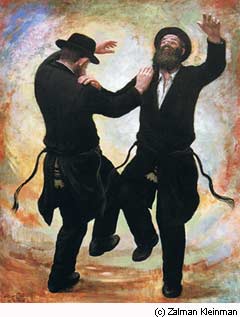
From the
Charleston to the
Mashed Potato to
Flossing, every dance move needs a name; but if you want to do the
Teshuva, you’ll need a Rabbi to show you how.
Teshuva is the Hebrew word for repent, or return. In it’s various forms the root of teshuva is used nearly a thousand times in the Old Testament. When Adam is fated to return to the ground (Genesis 3:13) at the end of his days, the root word is introduced for the first time. Throughout the Old Testament the connections between “return” and “repent” run deep and strong. When Jesus told the parable of the Prodigal Son, every Jewish listener understood the depth and significance of the words, “I will arise and return to my father.” (Of course, the Lord’s story ends in a surprising and unexpected celebration of the return!)
Rabbi Maimonides was a 12th-century teacher and Torah scholar who quite literally wrote the book on teshuva, The Laws of Repentance. Christians and Jews alike have leaned on Maimonides’s work for centuries, discovering the elements of regret, confession, penance, and even restitution that comprise the ingredients of repentance. Indeed, if Teshuvah were a dance, Rabbi Maimonides has laid out the steps.
The famous teacher located repentance in the act of confession, because no one will confess unless they first regret their actions and want to take concrete steps to return to the kind of life they had before sin worked its destruction in their hearts, their, minds, their families, and their communities. Both as individuals and as a community, the people of Israel understood the importance of taking action—an action of confession.
In a ceremony known as Yom Kippur, the nation-wide day of repentance, the high-priest over the entire community of Israel would confess the sins of the nation. Their regrets brought them together; their confession brought their sins to light. Regret is the first step in the great dance of repentance; confession is the second step. Regret motivates the return; confession completes the return. And I a a community context, this repentance was done together, acknowledging the sins of the community.
The Old Testament teshuvah dance also contained an individual element: when I have sinned I need not wait until the national day of mourning and confession—I could bring a sacrifice to the priest, and confess my individual sin. There first two steps of the dance are here again: regret brings me to the priest; confession begins the cleansing. But here, in the individual repentance of my personal sin, there was one more step in the dance: restitution—a return of what was stolen or damaged as a result of my actions. Moses, the Lawgiver of Israel, laid out these steps for the people of Israel:
“When a man or woman commits any of the sins of mankind, acting unfaithfully against the Lord, and that person is guilty then he shall confess his sins which he has committed, and he shall make restitution in full for his wrong and add to it one-fifth of it, and give it to him whom he has wronged.”
(Numbers 5:6-7)
The individual teshuvah dance is three steps: return to the priest, confess my sin, and make the damaged person whole.
Regret. Confession. Restitution. These are no longer in vogue, even among the religiously minded. And to be sure, this is the Old Testament picture of repentance, the three-step teshuvah. In God’s great economy, this picture of repentance is transformed in the life, death, and resurrection of Jesus. Still, “Rabbi Jesus,” a thousand years before Rabbi Maimonides, was making all things new—including repentance.
In Jesus’s ministry, how important is the call to repent? It’s the very first word of the good news. Jesus calls us to repent no less than our brothers and sisters the Old Testament age. And yet, the Lord carefully preserves these three steps and invites us into a dance grander and greater still.
 Repentance
Repentance  Repentance
Repentance  Thursday, July 25, 2019 at 03:52PM
Thursday, July 25, 2019 at 03:52PM  From the Charleston to the Mashed Potato to Flossing, every dance move needs a name; but if you want to do the Teshuva, you’ll need a Rabbi to show you how.
From the Charleston to the Mashed Potato to Flossing, every dance move needs a name; but if you want to do the Teshuva, you’ll need a Rabbi to show you how.
Reader Comments